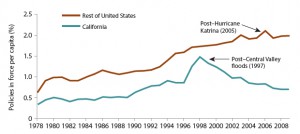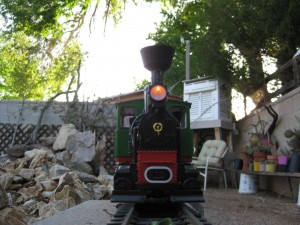In trying to understand California’s efforts to deal with its Bay-Delta water problems, I’ve been digging into the Delta Stewardship Council and Bay Delta Conservation Plan processes, and frankly have been left feeling a bit like Dorothy upon her descent into Oz – lots of familiar cues, but over and over again things weren’t quite making sense. (And, like Dorothy, I’m finding the people delightful, but the place is scary, and they keep sending me on my way, thinking I’ve got enough information to make it through. I don’t.)

It landed on the Wicked Witch in the middle of a ditch
People I talked to and things I read didn’t seem quite capable of explaining what these two processes are, and how they might lead to physical infrastructure and agreed-upon, binding plans for managing the region’s oversubscribed water resources. The light bulb finally went off as I was reading the draft National Research Council panel report on BDCP science: the reason I was having such a hard time was that the processes themselves are not clearly defined. From the report:
The legal framework underlying the BDCP is complex, as are the challenges of assembling such a large habitat conservation plan. Nonetheless, the BDCP’s purpose or purposes need to be clearly stated, because their nature and interpretation are closely tied to the BDCP’s scientific elements. The lack of clarity makes it difficult for this panel and the public to properly understand, interpret, and review the science that underlies the BDCP. (p.3)
Some background for those not already steeped: Most of California’s water flows through the delta formed by the San Joaquin and Sacramento Rivers as they make their way to San Francisco Bay. Much of California’s water falls in the north, and much is used in the south. So at the south end of the delta, giant pumps suck water and push it to south-of-delta users. This has been enormously successful, if you happen to be a south-of-delta farmer making the desert bloom, or an ubermetropolis like, say, the Los Angeles-plex. But it’s left some problems behind – for the people and ecosystem in the delta itself. Sorting out the conflicting values and interests in and around the delta has occupied California water politics for decades, precisely because it’s a really hard problem.
From the NRC:
There is simply not enough water to serve all desired uses. The situation surrounding the Delta is a symptom of scarcity. (p.8)
The underlying basics of the BDCP seem simple – the creation of a Habitat Conservation Plan for the management of the effects of continued Delta water withdrawals to meet federal Endangered Species Act requirements, and a Natural Community Conservation Plan to meet parallel requirements under state law. But as I’m coming to understand, much is hidden behind that deceptively simple facade.
For starters, hidden behind that is a multi-billion dollar notion that a Peripheral Something (tunnel? pipe? canal?) would be built to shunt the water coming down from the north around the delta to the pumps in the south. So instead of fouling up the delta itself by sucking water through it to the pumps, you let the delta function in a more natural way (albeit with a lot less water). For water engineering types, the Peripheral Something is the One Answer, and I have no reason to doubt them. There is opposition to the idea, though I don’t have a feel yet for how substantial it might be (see Brett Baker’s arguments last week in the San Francisco Chronicle, for example). But the BDCP process makes clear that, for California officialdom, the Peripheral Something is Plan A, and there doesn’t really seem to be a Plan B. Notes the NRC, in the money quote (“isolated conveyance” is jargon for “Peripheral Something”):
The lack of an appropriate structure creates the impression that the entire effort is little more than a post-hoc rationalization of a previously selected group of facilities, including an isolated conveyance facility, and other measures for achieving goals and objectives that are not clearly specified. (p.43)
So what we have here, it appears, is an effort to create the framework to somehow implement a decision made, rather than a process of making a decision? That seems to be the NRC’s central complaint.
That decision, to build big infrastructure to move more water around California, may be the right one. But in my guise as the naive Dorothy having just dropped into this strange world of California, it’s not clear to me that decision has, in fact, been made, and by who.
And herein lies the problem, so clearly spelled out in the NRC report (expanding on the bit quoted earlier):
Water scarcity in California is very real, the situation is legally and politically complex, and many stakeholders have differing interests. The effective management of scarcity requires not only the best science and technology, but also consideration of public and private values, usually through political processes, to arrive at plans of action that are scientifically based but also incorporate and reflect the mix of differing personal and group values. (p.8)
To reiterate a question I posed a while back right after my house fell on the witch and I began wandering this strange land, where is that political process, wherein competing values and interests are genuinely sorted out, taking place?
OtPR, whose insights into these processes are invaluable, suggests implicitly that the answer to my question is “nowhere”:
It (the BDCP) was well developed along a few lines; it had a long wishlist of restoration projects and fantasy of a Peripheral Canal and a notion of adaptive management. But nothing controversial, like flows, or the purpose of the Plan itself (is a habitat conservation plan or a way to justify a Peripheral Canal?) or priorities, was settled. Without the external review, I bet that could go on for another decade.This is how we do stuff and honestly, I understand why. Wading into the controversial realms is so painful. We just saw ACWA and a bunch of water districts act like thugs when the Delta Stewardship Council got into the controversial issue of regulating local control for consistency with their plan. We’ve seen Westlands and the State Water Contractors shut down BDCP by withdrawing funding. The legislature itself has punted; wisely realizing that they can’t weather the political storms that come with making Delta decisions, they delegated their power to a Delta Council made up of people who will never again run for office. As a subjective professional experience, the political storms suck.
But so do the products of processes that avoid them.
For you California water gurus in the audience, I’m happy to stand corrected or have help clarifying any of this.




 The Los Angeles Times reports that tragedy has struck the dinosaurs of Cabazon.
The Los Angeles Times reports that tragedy has struck the dinosaurs of Cabazon.